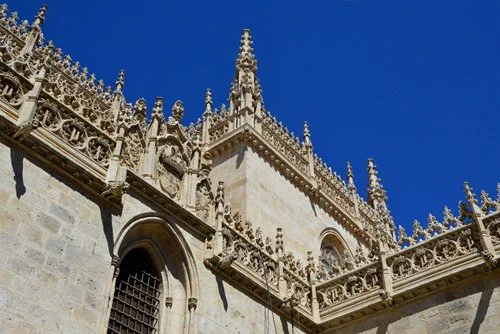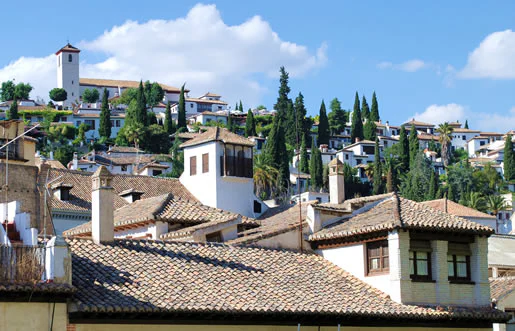The Royal Chapel is one of the most important historical monuments in the city of Granada and a must-visit spot for lovers of Spanish art, architecture, and history. It houses the mortal remains of the Catholic Monarchs, King Ferdinand of Aragon and Queen Isabella of Castile, their daughter Queen Joanna I, her husband King Philip I, and Prince Miguel. Prince Miguel, who died at age two, was heir to Castile, born to King Manuel I of Portugal and Isabella, the eldest daughter of the Catholic Monarchs, who passed away during childbirth.
History of the Royal Chapel
In September 1504, the Catholic Monarchs decided their remains would rest in Granada and, for that purpose, issued a Royal Decree creating the Royal Chapel. Just two months later, Queen Isabella passed away and, in her will, expressed the wish to be buried in Granada, specifically in the Convent of San Francisco in the Alhambra.
The queen chose Granada for its symbolic status as the last stronghold of Islam in the Iberian Peninsula. Moreover, the conquest of Granada was a personal obsession that deeply marked Queen Isabella.
King Ferdinand died two years later and, despite remarrying, was buried alongside Queen Isabella in the Convent of San Francisco.
In 1521, Charles V, upon completion of the Royal Chapel, transferred his grandparents’ remains from the Convent of San Francisco to the Royal Chapel.
Architecture of the Royal Chapel
The chapel was built between 1505 and 1517 and is dedicated to Saint John the Baptist and Saint John the Evangelist. Its construction was entrusted to architect Enrique Egas, with the condition that it be integrated with the Granada Cathedral.
The chapel has only one external façade, as the other three sides are joined to the Cathedral, the Lonja, and the Sagrario. Its walls are supported by buttresses decorated with elegant pinnacles and openwork parapets, crowned with sophisticated crenellation. The decorations also include gargoyles, soberly designed windows, and the coats of arms and initials of the Catholic Monarchs displayed throughout.
The Mausoleum of the Catholic Monarchs
The tomb of King Ferdinand and Queen Isabella is the work of Florentine sculptor Domenico Fancelli. It is a freestanding funerary monument with a truncated pyramidal shape.
The reclining figure of the King is depicted in armor and a cloak, holding his sword, with a finely detailed face. The Queen, in contrast, is dressed simply, her hands resting gently on her body to symbolize humility and honesty. At their feet lie two lions, symbols of royalty and vigilance.
The main body of the tomb bears themes that directly relate to the image the monarchs wanted to convey of themselves.
The sides of the tomb are decorated with four medallions. Those on the ends depict Santiago, patron of Castile, at the foot, and Saint George, patron of Aragon, at the head, both portrayed as victorious horsemen. The other two show Christ in scenes of Baptism and Resurrection. Along each side of the tomb, niches contain seated figures of the twelve apostles.
At each corner, above the cornice, are statues of the four Latin Fathers of the Church: Saint Augustine and Saint Ambrose at the foot, and Saint Gregory the Great and Saint Jerome at the head.
Above the tomb, cherubs hold the royal coats of arms, while an inscription at the foot commemorates that Ferdinand of Aragon and Isabella of Castile, the Catholic Monarchs, husband and wife, are buried here.
The Mausoleum of Philip I and Joanna I of Castile
The mausoleum of Queen Joanna and King Philip was created by three sculptors: Domenico Fancelli, Bartolomé Ordóñez, and Pietro de Carona. Ordóñez made significant modifications to the original design by Fancelli, adding a sarcophagus for the reclining statues.
The fronts of the tomb retain the usual arrangement of niches and medallions. The medallions depict biblical scenes such as the Nativity, Epiphany, the Agony in the Garden, and the Descent from the Cross. Figures within the niches represent the Theological Virtues (Faith, Hope, and Charity) and the Cardinal Virtues (Prudence, Justice, Fortitude, and Temperance). Five allegories of the Gifts of the Holy Spirit complete the decoration, although their representation deviates from traditional iconography.
Additional figures with different meanings are found on the tomb. A strong man symbolizes Gideon, a heroic figure in Christian tradition. Three figures holding books likely represent intellectual disciplines such as Arithmetic or Rhetoric. An elderly woman in flowing robes is usually identified as Theology. A female figure at the foot of the tomb might represent Grammar, while another female figure with hands in prayer and a wound on her chest suggests Saint Anastasia, a symbol of resurrection.
The tomb's corners are adorned with monstrous figures. These complexly designed figures combine human torsos, wings, bird bodies, and lion claws, interpreted as satyrs, tritons, sphinxes, harpies, or sirens. The female figures, near the altar, have youthful, Venus-like forms, while the male figures, at the head, display bearded, more serious faces. Each creature is accompanied by a naked child (two of whom are winged) clambering over or playfully held by them.
The sarcophagus design is inspired by Roman and Renaissance models. Protective saints of both royal houses adorn the corners: Saint John the Baptist and Saint John the Evangelist on Joanna's side, and Saint Andrew and Saint Michael on Philip's side. The tomb sides are decorated with crowned coats of arms, guarded by Saint John’s eagle and held by angels. Joanna’s coat of arms is encircled by a collar with pomegranates and arrows, while Philip’s bears the Order of the Golden Fleece.
The royal couple is depicted with clothing and symbols appropriate to their rank: King Philip is dressed in armor and a dalmatic decorated with the coats of arms of Austria, Burgundy, Flanders, and the Spanish kingdoms, with an ermine-lined cape and the Golden Fleece, holding his sword with both hands. Queen Joanna has a serene, idealized face, dressed elegantly in Burgundian style, holding a scepter and wearing a rich necklace. Their youthful and stylized figures follow Franco-Flemish fashion, with an idealized look devoid of realistic character, emphasizing Joanna's elongated face. At their feet lie a lion and a lioness. Within the mausoleum, Joanna occupies a higher hierarchical position, similar to her mother, Isabella.
The Crypt
Under the mausoleums is a small and austere crypt where the royal coffins, made of lead and identified by initials, are placed.
The High Altarpiece
The High Altarpiece of the Royal Chapel of Granada, created between 1520 and 1522, is a unique Gothic work commissioned by Queen Joanna I of Castile to honor her parents, the Catholic Monarchs. This altarpiece, designed by Felipe Bigarny, integrates Flemish style with Renaissance influences. It is dedicated to the life of Christ and the Virgin Mary and is composed of two levels and five sections.
The altarpiece is divided into detailed scenes from the lives of Jesus and Mary, focusing on key moments such as the Annunciation, the Nativity, the Adoration of the Magi, the Crucifixion, and the Resurrection. Each scene is exquisitely sculpted, guiding the viewer through the life of Christ in chronological order.
At the center is a figure of the Virgin and Child, a symbol of devotion and the focal point of the piece. The upper section is crowned by an image of the Resurrected Christ, symbolizing victory over death and the promise of eternal life. Saints and martyrs enrich the altarpiece’s religious significance, with each figure detailed and expressive.
Bigarny's style, marked by his ability to capture expressions and emotions, is evident in each scene. The figures exhibit dynamism and realism, with fine details that highlight the Renaissance influence in this Gothic work.
This altarpiece is not only an artistic masterpiece but also a testament to the Catholic Monarchs’ faith and devotion. Its presence in the Royal Chapel, the burial place of Isabella and Ferdinand, reinforces the connection between the monarchy and religion at that time, emphasizing the power and spirituality the Catholic Monarchs sought to project.
The Grand High Altarpiece of the Royal Chapel of Granada is a masterwork of Spanish religious sculpture, embodying not only a legacy of faith but also the peak of Renaissance art in Spain. With its impressive detail and structure, it remains one of the foremost artistic and religious attractions of the Royal Chapel.
The Lonja
Founded in 1518 and sponsored by banker Esteban Centurión, the Lonja of the Royal Chapel of Granada is a Renaissance structure that served as a commercial hub in the 16th century. Its design showcases Gothic and Mudejar art, with a strong Renaissance style in its decoration. After several restorations, the site displays a Mudejar coffered ceiling, art pieces, and a hall featuring a replica of Francisco Pradilla’s painting *The Surrender of Granada*, making this building a worthy entrance to the Royal Chapel .
Visiting the Royal Chapel
Visiting hours for the Royal Chapel are Monday to Saturday from 10:00 a.m. to 6:30 p.m., and Sundays from 11:00 a.m. to 6:30 p.m. (closing at 7:00 p.m.).
The Royal Chapel is closed on Good Friday, December 25, and January 1.
It has reduced hours: December 24 and 31 from 10:00 a.m. to 1:00 p.m., January 6 from 11:00 a.m. to 6:30 p.m., and January 2 from 4:00 p.m. to 6:30 p.m.
Tourist visits are suspended during liturgical ceremonies.
Accessibility to the monument may have certain limitations. Given its historical and monumental nature, external installations are not possible. It is recommended to inquire about specific accessibility options beforehand to determine if they meet your needs.
The most recommended and tranquil visiting time is early in the morning.
The Royal Chapel offers an audio guide service in multiple languages.
How to Get to the Royal Chapel
On Foot
The Chapel is centrally located in Granada, easily accessible from anywhere in the city. Access to the Royal Chapel is through the former Merchants' Hall on Calle Oficios, a pedestrian street accessible from Gran Vía or Calle Reyes Católicos.
By Car
It is not possible to reach the Royal Chapel by car due to restricted private transport in the city center.
By Public Transport
You can reach the Royal Chapel of Granada via city bus lines 4, 8, 11, 21, 33, C31, C32, C34 (Gran Vía / the Cathedral stop), and C30, C35 (Plaza Isabel Católica stop).
A taxi can also be taken to the Royal Chapel.
Visitor Rules
No animals are allowed, except guide dogs.
Minors must be accompanied, and visitors are expected to maintain order, cleanliness, and a respectful attitude toward the heritage.
Upon entry, phones must be turned off. Taking photos and videos is not permitted.
No eating, drinking, or smoking is allowed.
Visitors should maintain silence, dress respectfully, and remove hats when inside.



